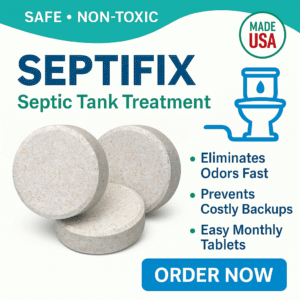Worried about maintaining your cesspool or septic system the right way?
Try SEPTIFIX – The #1 Septic Tank Treatment. It’s the ultimate monthly solution for eliminating odors, preventing system backups, and protecting your entire waste system—whether it’s a cesspool or a septic tank. Click here to start your maintenance the smart way.
Introduction
If your home relies on a private waste disposal system, chances are you’ve either got a cesspool or a septic tank. These systems serve a similar purpose—managing wastewater in areas without municipal sewer access—but they work very differently. Understanding their differences can help you make smarter maintenance decisions, save money, and avoid costly repairs or health risks.
This article explains everything you need to know about cesspools vs septic tanks: how they work, pros and cons, which is more efficient, and how to care for them properly.
What Is a Cesspool?
A cesspool (or cesspit) is an underground pit lined with concrete, brick, or stone that simply collects and holds household wastewater. It has perforated walls or a porous bottom that allows liquid waste to slowly seep into the surrounding soil. Solid waste, however, accumulates and must be pumped out regularly.
How Cesspools Work:
- Wastewater flows into the pit from household plumbing
- Liquids drain through the porous bottom or walls
- Solids remain and build up over time
- Requires frequent pumping to avoid overflow
What Is a Septic Tank?
A septic tank is a watertight underground chamber made of concrete, fiberglass, or plastic that treats household wastewater through bacterial decomposition. It separates solids, scum, and liquid. Liquids are discharged to a drain field where further filtration occurs naturally in the soil.
How Septic Tanks Work:
- Wastewater enters the tank and separates into three layers: sludge, liquid, and scum
- Solid waste is broken down by bacteria
- Effluent (treated liquid) flows into a drain field for final filtration
- Tank must be pumped every 3–5 years
Cesspool vs Septic Tank: Quick Comparison
| Feature | Cesspool | Septic Tank |
|---|---|---|
| Primary Function | Waste collection and seepage | Waste separation and partial treatment |
| Wastewater Treatment | Minimal (no real treatment) | Moderate (bacteria break down solids) |
| Drainage System | None or limited seepage area | Dedicated drain/leach field |
| Pumping Frequency | Every 1–2 years | Every 3–5 years |
| Health & Environmental Risks | Higher (can contaminate groundwater) | Lower (controlled drainage) |
| Legal Compliance | Often outdated or restricted | Widely approved by health departments |
| Installation Cost | Lower | Higher |
Pros and Cons of Cesspools
Pros:
- Lower installation cost
- Simpler design and fewer parts
- Useful in older or remote homes with no room for a drain field
Cons:
- Must be pumped more often
- No treatment of wastewater—just disposal
- High risk of soil and groundwater contamination
- May be banned or phased out in many areas
Pros and Cons of Septic Tanks
Pros:
- Better waste treatment and filtration
- Less frequent pumping needed
- Protects the environment with a drain field
- Approved in most residential building codes
Cons:
- More expensive to install
- Requires more space for the leach field
- Can clog if not properly maintained
Which One Is Safer and More Effective?
Septic tanks are much safer and more effective than cesspools. They actively separate waste, allow for bacterial treatment, and distribute effluent into a drain field, reducing the risk of contamination.
Cesspools, by contrast, don’t treat waste. They simply store it and allow liquid to seep out, which often leads to environmental and health hazards—especially if located near a well or water supply.
What Maintenance Does Each System Require?
Cesspool Maintenance:
- Pumping every 1–2 years
- Inspection for wall collapse or overflow
- Possible replacement if illegal or unsafe
Septic Tank Maintenance:
- Pumping every 3–5 years
- Inspection of tank and drain field annually
- Use of bacterial treatments like SEPTIFIX to enhance breakdown and reduce odors
Want to reduce septic odors, prevent clogs, and extend the life of your system?
Try SEPTIFIX—a once-a-month tablet that works in both septic tanks and cesspools to eliminate gases, improve flow, and keep your system healthy.
Legal and Environmental Considerations
In many areas, cesspools are being phased out or banned. Health departments and environmental agencies often require upgrades to septic systems because cesspools lack treatment ability and pose contamination risks.
Septic systems, when properly installed and maintained, meet modern environmental standards and are safe for both people and property.
Signs It’s Time to Upgrade from a Cesspool
- You notice sewage smell inside or outside the home
- Your cesspool is filling up faster than usual
- The system fails health inspections
- You’re building an addition or selling your home
Upgrading to a septic tank improves safety, value, and compliance—and combined with monthly treatment using SEPTIFIX, it helps you avoid expensive repairs.
Conclusion
While both cesspools and septic tanks manage household waste, the differences are major. Cesspools are outdated, riskier, and require frequent maintenance. Septic tanks, on the other hand, are more advanced, eco-friendly, and cost-efficient in the long run.
Whether you’re upgrading your system or maintaining an existing one, monthly care is essential. Try SEPTIFIX to eliminate odors, boost bacteria, and extend the life of your waste system—no matter what kind you use.
